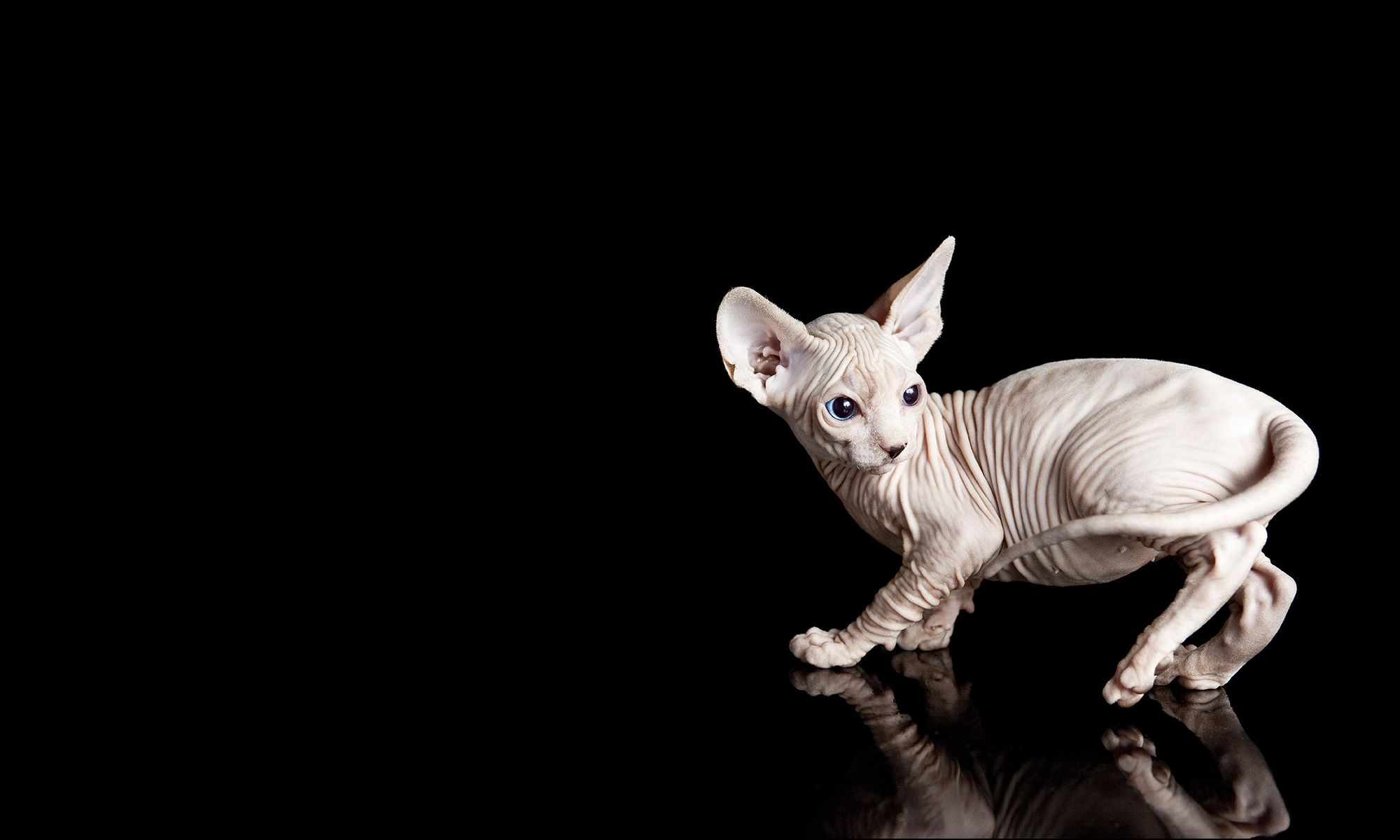Sphynx is one of the world’s oldest feline breeds. Naked cats have a rich history, which stretches back to times of Egyptian pharaohs. As legend says, a white sphynx with blue eyes kept guard over sanctuaries of ancient Egypt. Naked cats have also been found in ancient Aztec tribes. Being practical by nature, Aztecs used these cats as live heaters.
Cats of the extinct ancient breed, Mexican Hairless, were shown at first cat shows in the USA at the beginning of the 20th century. The last couple of the breed had lived until the early 30s without leaving any kittens. Mexican Hairless resembled the modern Sphynx, but some essential differences have been noted: a longer body, wedge-shaped head with amber-colored eyes and normal whiskers. During the colder season it grew a ridge of fur down the mid back and tail. The origin of this mutation is still unknown. Possibly, Mexican Hairless was genetically close to Donskoy Sphynx as they both, being hairless, were normally whiskered and seasonally coated.
Hairless kittens had occasionally appeared in litters of domestic cats around the world. In 1938 a French professor E. Letard described the mutant allele “h” in hairless kittens produced by a pair of Siamese.
Hairless cats were reported in England and Scandinavia as well, but no attempts have been made to launch the breeding program in these countries. The origination of a breed of hairless cats began in 1966, when a completely naked kitten (later named Prune) spontaneously appeared in the litter of an ordinary domestic shorthair queen in Ontario (Canada). In due time, Prune was bred to his mother and one more naked kitten was born. They mated Prune to his daughters and granddaughters as long as possible to fix the bare recessive gene.
As the result of such matings two variants of Sphynx breed appeared. In 1970, The Cat Fanciers Association (CFA) granted provisional status to the “Canadian Hairless”. The next year however, CFA withdrew recognition due to the health problems and breeding difficulties. Sphynx breeding failed for a variety of reasons. First, the breed was extremely small in number and there was no hope to make it stable using only disposable cats. Besides, the breeders did not learn well the peculiarities of Sphynx genetics (at that time, it was wrongly believed that the gene associated with hairlessness was connected with the sex of the kitten). Secondly, Sphynx kittens required more care than their coated fellows, and so they often died. Lastly, the first breeders did not have a proper breeding strategy. So that line then became extinct.
The Sphynx as we know it today began in 1975, when a farm domestic shorthair female in Wadena (Minnesota) gave birth to a naked kitten, named Epidermis. A year later a female kitten Dermis appeared there. Both kittens were taken to Z.Stardust cattery, where Epidermis became the pioneer of some elite Sphynx lines of the present day.
In the late 1970’s three more naked kittens (1 male and 2 females) were found in Toronto streets. Unfortunately, the male Bambi was badly injured: one of his eyes came out and he needed a surgical removal of the injured testicles. So Bambi couldn’t be used in breeding, though his excellent genotype fully deserved it. However, Bambi is famous as the longest-living Sphynx. He lived a long and happy life till his death at the age of 19. Two female cats, Punkie and Paloma, were sent to Netherlands to Doctor Hugo Hernandez who developed his own breeding program using Devon Rex for crossing. Thus Punkie and Paloma gave rise to the Sphynx breed in Europe. They can be found in many European and American Sphynx pedigrees.
Later on crosses between the Sphynx and Devon Rex helped support the gene pool of Canadian Sphynx and increase their numbers. Devon Rex was the most used breed for outcrossing as it most closely resembled Sphynx in looks and type. Moreover, outcrossing with Devon Rex only yielded naked kittens right in the first generation. However, such massive inflow of blood from different (albeit genetically close) breed had to have an impact on Sphynx. Some Sphynx of the present day lines often resemble bald Devon Rex of middling type with thin skin, shorter Devon-like head with eyes too rounded for Sphynx, lower set ears and sometimes with a bit delicate and bony body — a sure sign of degeneracy of Sphynx race. A wrinkled skin, a distinctive characteristic of first Sphynx, is becoming increasingly rare now in grown-up Sphynx. Kittens’ skin is still very loose and wrinkled, but as the cat ages the wrinkles will diminish remaining only round the muzzle, between the ears and round the shoulders. Sphynx of many of the present day lines, especially European and American originated from them, look more like elegant porcelain statuettes than odd gnomes they looked like before. Today, the most wrinkled specimens of the breed are coming from breed lines originated from legendary Epidermis but even they can’t come close to their ancestor. Continually through the years, a few other examples of «hairless» mutations have occurred in different places in USA, Canada and Russia. These specimens are highly valued and breeders try to use their breeding potential fully. Newly bred hairless become the pride of a cattery.

